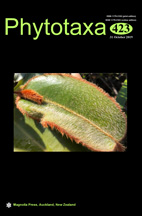Abstract
A new orchid species, Cymbidium atrolabium, from Yunnan Province, China, is described and illustrated based on morphological and molecular analyses. A detailed comparison between the newly discovered orchid and other members of Cymbidium was conducted. The new plant is similar to C. tortisepalum but differs by having a dark-purple inflorescence with smaller flowers, sepals that are pale green-yellow with a dark-purple broad midrib, petals that are dark-purple with pale green-yellow margins and a smaller, dark purple, densely papillose lip. Phylogenetic analyses based on nuclear ribosomal ITS and plastid (matK, rbcL) sequence data support the status of C. atrolabium as a new species.

